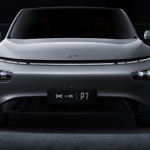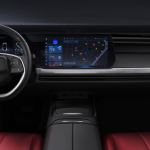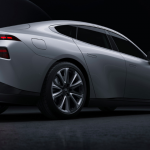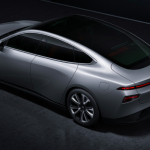

News
Tesla-inspired Xpeng Motors unveils Model 3 competitor despite Autopilot lawsuit
China’s Xpeng Motors recently unveiled its answer to the Tesla Model 3, the P7 sedan. The vehicle is impressive, packing up to 440 miles of range per charge under NEDC standards at a price that undercuts more established rivals. But the company’s competition with Tesla goes beyond the pavement and well into the courtroom.
Xpeng issued a press release on April 27 announcing the official launch of its second production model vehicle. The P7 is currently available for order in China in three versions: a 4WD High Performance trim that can hit 0-100 km/h in 4.3 seconds, an RWD Super Long Range variant that goes 440 miles under the NEDC cycle, and the entry level RWD Long Range. The all-electric sedan uses 12 ultrasonic sensors, five millimeter-wave radars, and 14 cameras to operate its autonomous driving system, which is known as XPILOT3.0. After subsidies, the car will cost between $32,462 and $49,404.
“Today is a milestone in the 5-year history of Xpeng Motors,” Chairman and CEO He Xiaopeng said. “The P7’s launch solidifies Xpeng Motors’ leading position in China’s smart EV market. Our ability to launch the P7 in the challenging conditions of the COVID-19 crisis is a testament to the strength of our young company.”
However, Xpeng’s presence in the world of electric vehicles goes much further than the launch of its new car. The company is currently in a legal battle with Tesla, who is suing a company engineer for allegedly stealing Autopilot’s source code prior to starting his employment at the Chinese automaker.
- Credit: Xpeng Motors
- Credit: Xpeng Motors
- Credit: Xpeng Motors
- Credit: Xpeng Motors
Tesla accused Guangzhi Cao of downloading Autopilot’s source code to his personal computer and transferring it via Apple Airdrop before selling it to Xpeng for financial gain. Airdrop is a complicated method to trace because it uses Transport Layer Security (TLS) encryption. Cao, for his part, maintains that he did download some of Autopilot’s source code to his personal computer, but he argued that he deleted it before leaving Tesla to join Xpeng.
Unfortunately for the Chinese EV startup, Tesla’s Autopilot source lawsuit is turning ugly. The most recent developments in the lawsuit state that Xpeng is claiming Tesla’s requests are “stereotypical” after the company demanded information from an ex-employee of Apple. Just like Cao, the ex-Apple employee left his job for Xpeng and was criminally charged with providing information to the Chinese automaker, Automotive News stated.
“Tesla’s latest demands crossed the line, seeking to rummage through our IP on Tesla’s terms — and smearing us along the way with misrepresentations and innuendo,” a spokesperson from Xpeng’s U.S. affiliate, XMotors, said. “Tesla’s overreach and distortions confirm this is just a fishing expedition meant to bully and disrupt a young competitor.”
Interestingly enough, Xpeng executives have been vocal supporters of Tesla in the past. President and Vice Chairman of Xpeng, Brian Gu, has passed along compliments to Tesla, comparing them to technology giant Apple. “Tesla reminds me of Apple. It educated the high-end market for China, but it also spurred a lot of competitive, diverse brands like Xiaomi and Huawei to come up with really cool and affordable products,” Gu said.
Additionally, CEO He Xiaopeng stated that the company probably would not exist if Tesla didn’t release 200 patents to the public a few years ago. One of the reasons Xpeng was founded was because Elon Musk made Tesla’s patents available. It was so exciting,” he said. However, these patents did not include any Autopilot coding, which is instrumental in Tesla’s lead in the autonomous vehicle industry.
Xpeng’s full press release is available here.

Elon Musk
Elon Musk’s X will start using a Tesla-like software update strategy
The initiative seems designed to accelerate updates to the social media platform, while maintaining maximum transparency.

Elon Musk’s social media platform X will adopt a Tesla-esque approach to software updates for its algorithm.
The initiative seems designed to accelerate updates to the social media platform, while maintaining maximum transparency.
X’s updates to its updates
As per Musk in a post on X, the social media company will be making a new algorithm to determine what organic and advertising posts are recommended to users. These updates would then be repeated every four weeks.
“We will make the new 𝕏 algorithm, including all code used to determine what organic and advertising posts are recommended to users, open source in 7 days. This will be repeated every 4 weeks, with comprehensive developer notes, to help you understand what changed,” Musk wrote in his post.
The initiative somewhat mirrors Tesla’s over-the-air update model, where vehicle software is regularly refined and pushed to users with detailed release notes. This should allow users to better understand the details of X’s every update and foster a healthy feedback loop for the social media platform.
xAI and X
X, formerly Twitter, has been acquired by Elon Musk’s artificial intelligence startup, xAI last year. Since then, xAI has seen a rapid rise in valuation. Following the company’s the company’s upsized $20 billion Series E funding round, estimates now suggest that xAI is worth tens about $230 to $235 billion. That’s several times larger than Tesla when Elon Musk received his controversial 2018 CEO Performance Award.
As per xAI, the Series E funding round attracted a diverse group of investors, including Valor Equity Partners, Stepstone Group, Fidelity Management & Research Company, Qatar Investment Authority, MGX, and Baron Capital Group, among others. Strategic partners NVIDIA and Cisco Investments also continued support for building the world’s largest GPU clusters.
News
Tesla FSD Supervised wins MotorTrend’s Best Driver Assistance Award
The decision marks a notable reversal for the publication from prior years, with judges citing major real-world improvements that pushed Tesla’s latest FSD software ahead of every competing ADAS system.

Tesla’s Full Self-Driving (Supervised) system has been named the best driver-assistance technology on the market, earning top honors at the 2026 MotorTrend Best Tech Awards.
The decision marks a notable reversal for the publication from prior years, with judges citing major real-world improvements that pushed Tesla’s latest FSD software ahead of every competing ADAS system. And it wasn’t even close.
MotorTrend reverses course
MotorTrend awarded Tesla FSD (Supervised) its 2026 Best Tech Driver Assistance title after extensive testing of the latest v14 software. The publication acknowledged that it had previously criticized earlier versions of FSD for erratic behavior and near-miss incidents, ultimately favoring rivals such as GM’s Super Cruise in earlier evaluations.
According to MotorTrend, the newest iteration of FSD resolved many of those shortcomings. Testers said v14 showed far smoother behavior in complex urban scenarios, including unprotected left turns, traffic circles, emergency vehicles, and dense city streets. While the system still requires constant driver supervision, judges concluded that no other advanced driver-assistance system currently matches its breadth of capability.
Unlike rival systems that rely on combinations of cameras, radar, lidar, and mapped highways, Tesla’s FSD operates using a camera-only approach and is capable of driving on city streets, rural roads, and freeways. MotorTrend stated that pure utility, the ability to handle nearly all road types, ultimately separated FSD from competitors like Ford BlueCruise, GM Super Cruise, and BMW’s Highway Assistant.
High cost and high capability
MotorTrend also addressed FSD’s pricing, which remains significantly higher than rival systems. Tesla currently charges $8,000 for a one-time purchase or $99 per month for a subscription, compared with far lower upfront and subscription costs from other automakers. The publication noted that the premium is justified given FSD’s unmatched scope and continuous software evolution.
Safety remained a central focus of the evaluation. While testers reported collision-free operation over thousands of miles, they noted ongoing concerns around FSD’s configurable driving modes, including options that allow aggressive driving and speeds beyond posted limits. MotorTrend emphasized that, like all Level 2 systems, FSD still depends on a fully attentive human driver at all times.
Despite those caveats, the publication concluded that Tesla’s rapid software progress fundamentally reshaped the competitive landscape. For drivers seeking the most capable hands-on driver-assistance system available today, MotorTrend concluded Tesla FSD (Supervised) now stands alone at the top.
News
Elon Musk’s Grokipedia surges to 5.6M articles, almost 79% of English Wikipedia
The explosive growth marks a major milestone for the AI-powered online encyclopedia, which was launched by Elon Musk’s xAI just months ago.

Elon Musk’s Grokipedia has grown to an impressive 5,615,201 articles as of today, closing in on 79% of the English Wikipedia’s current total of 7,119,376 articles.
The explosive growth marks a major milestone for the AI-powered online encyclopedia, which was launched by Elon Musk’s xAI just months ago. Needless to say, it would only be a matter of time before Grokipedia exceeds English Wikipedia in sheer volume.
Grokipedia’s rapid growth
xAI’s vision for Grokipedia emphasizes neutrality, while Grok’s reasoning capabilities allow for fast drafting and fact-checking. When Elon Musk announced the initiative in late September 2025, he noted that Grokipedia would be an improvement to Wikipedia because it would be designed to avoid bias.
At the time, Musk noted that Grokipedia “is a necessary step towards the xAI goal of understanding the Universe.”
Grokipedia was launched in late October, and while xAI was careful to list it only as Version 0.1 at the time, the online encyclopedia immediately earned praise. Wikipedia co-founder Larry Sanger highlighted the project’s innovative approach, noting how it leverages AI to fill knowledge gaps and enable rapid updates. Netizens also observed how Grokipedia tends to present articles in a more objective manner compared to Wikipedia, which is edited by humans.
Elon Musk’s ambitious plans
With 5,615,201 total articles, Grokipedia has now grown to almost 79% of English Wikipedia’s article base. This is incredibly quick, though Grokipedia remains text-only for now. xAI, for its part, has now updated the online encyclopedia’s iteration to v0.2.
Elon Musk has shared bold ideas for Grokipedia, including sending a record of the entire knowledge base to space as part of xAI’s mission to preserve and expand human understanding. At some point, Musk stated that Grokipedia will be renamed to Encyclopedia Galactica, and it will be sent to the cosmos.
“When Grokipedia is good enough (long way to go), we will change the name to Encyclopedia Galactica. It will be an open source distillation of all knowledge, including audio, images and video. Join xAI to help build the sci-fi version of the Library of Alexandria!” Musk wrote, adding in a later post that “Copies will be etched in stone and sent to the Moon, Mars and beyond. This time, it will not be lost.”












